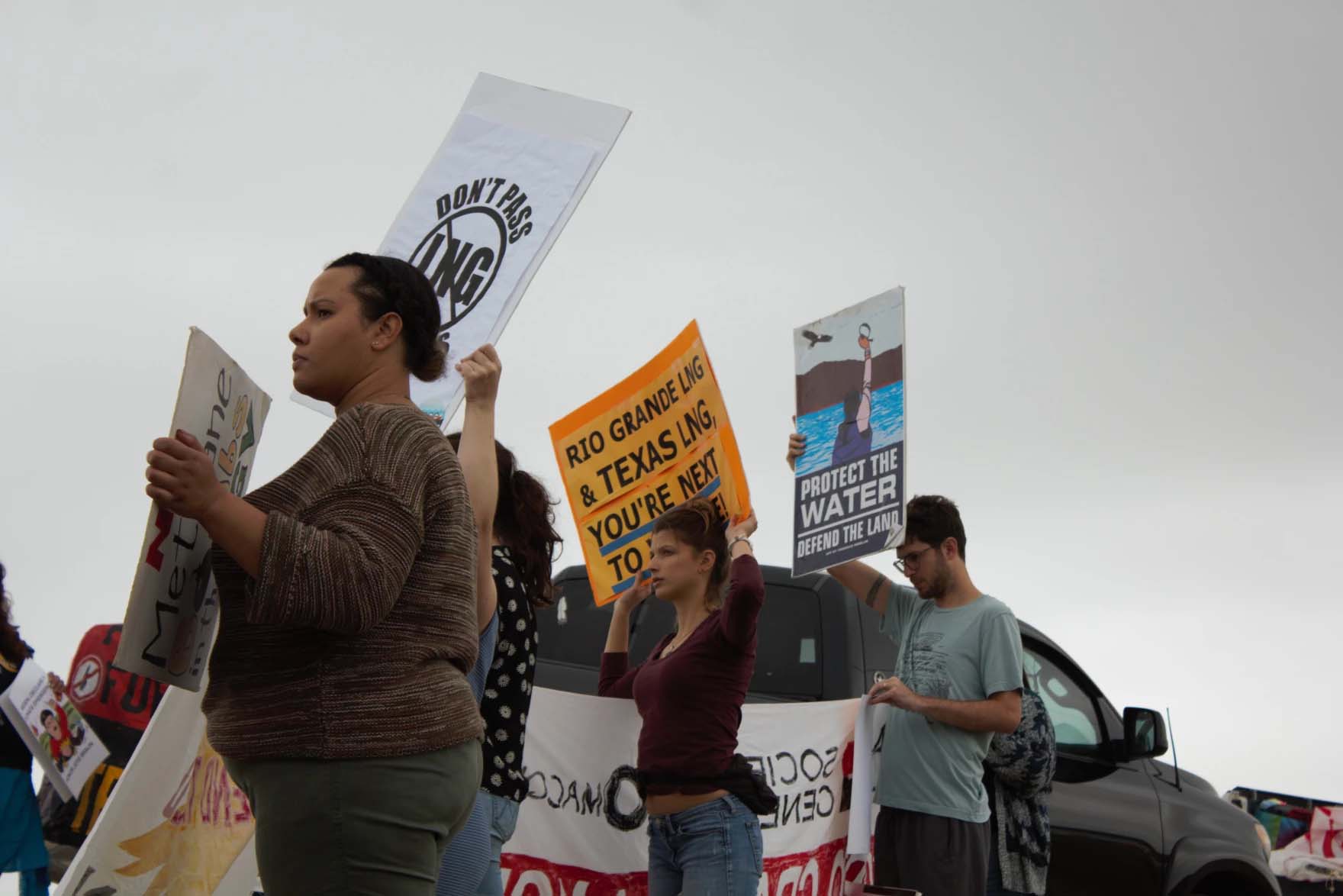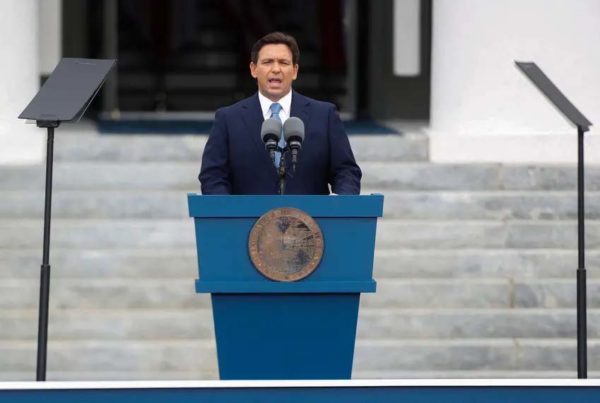From Texas Public Radio and DeSmog:
As the Mexican Día de los Muertos, or Day of the Dead, festivities drew to a close, Dina Nuñez called to order a meeting of women grassroots activists in a modest home in the heart of Port Isabel, Texas. Top of her agenda: how to stop a Houston-based oil and gas company from building a 10-billion-dollar project to export liquefied natural gas on a nearby stretch of coast.
For Nuñez and her friends, the fight against the scheme – known as Rio Grande LNG – is about protecting their community from air pollution; preserving shrimping and tourism; and defending habitats for pelicans, endangered ocelots and aplomado falcons at the project site on unspoiled wetlands between Port Isabel and the larger city of Brownsville.
The claim by developer NextDecade to be building the “greenest LNG project in the world” has thrust the women to the forefront of a global struggle. At a time when scientists warn there can be no new fossil fuel developments if the world is going to avoid the worst impacts of the climate crisis, oil and gas executives are turning to a technology known as carbon capture and storage, or CCS, to convince investors, politicians, and the public their expansion plans are climate-safe.
“This is a poor community, yes. We’re not saying we don’t need jobs,” Nuñez said, shortly before the meeting of volunteers with the Neighbors for the Wellness of the Coastal Community group, known in Spanish as Vecinos para el Bienestar de la Comunidad Costera. “But we don’t need work that affects the environment, and ultimately, the health of the community.”
A prime example of the ups and downs of the American liquefied natural gas industry, plans to build Rio Grande LNG faltered in 2020 as demand for energy cratered during the Covid-19 pandemic, and concern over its climate impact grew. But the scheme has been resurrected thanks to a European scramble for LNG triggered by Russia’s invasion of Ukraine, and a new twist on the original design – the use of CCS to portray the facility as a source of “clean” energy.
These claims hinge on a proposal by NextDecade to use CCS to capture more than 5 million tons a year of the carbon dioxide (CO2) produced during the process of supercooling the gas for loading on to specialized tankers for export. The company says it will be one of the biggest CCS systems in North America – and the first LNG terminal to reduce its CO2 emissions by more than 90%.
“NextDecade is a clean energy company accelerating the path to a net-zero future,” NextDecade chief executive Matthew Schatzman told a conference call to present the CCS plan to financial analysts in March 2021. “Efforts to reduce global greenhouse gas emissions are at the very foundation of our company.”
Opponents point out there’s a big catch, however. Only 6-7% of the overall emissions associated with such projects are generated during the process of cooling the gas, according to a 2019 study by the Department of Energy. That means that the proposed CCS plant could only ever mitigate a small fraction of Rio Grande LNG’s total climate impact.
And that impact could be considerable. The Sierra Club estimates that building Rio Grande LNG could generate up to 163 million tons of carbon dioxide equivalent emissions a year – comparable to 44 coal plants, or more than 35 million cars. That analysis factors in the potential emissions of carbon dioxide and methane, a powerful climate pollutant, associated with the production, transport, and end-use of the natural gas.
NextDecade did not respond to multiple requests for comment.
“Carbon capture is like trying to put a Band-Aid on a bullet hole,” said Bekah Hinojosa, a Brownsville artist, community organizer, and Gulf Coast campaign representative for the Sierra Club. “The project itself is highly destructive in so many different ways and would still release a tremendous amount of toxic air pollution into our impoverished brown and Indigenous community.”
Technical and economic hurdles mean that there are only 30 commercial CCS projectsin operation worldwide – many of which are used to extract more oil by re-injecting carbon dioxide into wells. The industry-backed Global CCS Institute estimates the capacity of these existing installations is 43 million tons of carbon dioxide a year – about 0.1% of global emissions.
Nevertheless, as calls for oil and gas companies to reduce their climate impacts have intensified, interest in CCS has grown. In September, the total capacity of commercial CCS projects in the planning stages grew 44% over the previous year, to 244m tons per annum of CO2, according to the Global CCS Institute.
At least 15 planned or existing LNG export or upstream gas projects globally have announced plans to add CCS, according to a tally by non-profit climate news service DeSmog. These include five in Louisiana and Texas planned by companies including NextDecade, G2 Net-Zero LNG, Venture Global, Sempra Energy, and French giant TotalEnergies.
Revived project
First proposed in 2015, Rio Grande LNG stirred opposition from residents concerned about the kinds of fossil fuel mega-projects seen on other parts of the Gulf Coast arriving on their doorstep. Building the terminal would bulldoze a Central Park-sized area of land sacred to the Carrizo Comecrudo Tribe of Texas to erect giant storage tanks and flaring towers, and force local fishers to contend with LNG tanker ships three football fields long.
The plan suffered a public blow when French utility Engie pulled out of talks with NextDecade to buy LNG for 20 years for $7 billion in November 2020. Media reports at the time said the French government, a part-owner of Engie, was concerned about methane emissions from the production of the fracked gas for the facility in the Permian Basin.
The next March, NextDecade announced it would add CCS to the planned project. The company has also unveiled plans to procure “responsibly sourced” gas, and work with Project Canary, an environmental data company, to measure the greenhouse gas intensity of its LNG exports.
But the project may not have been revived were it not for Russia’s invasion of Ukraine, which injected new life into the LNG industry as Europe rushed to secure alternatives to Russian pipeline gas. In May, NextDecade announced it had signed a 15-year agreement with Engie, with the first LNG shipping as early as 2026. Engie did not respond to repeated requests for comment.
Preliminary tree-felling work at the site has since started, though the company has yet to make a crucial final investment decision on the project. It is also unclear precisely where NextDecade plans to store any carbon dioxide captured by its planned CCS plant. The company said in an August presentation to investors that geologic storage sites were being assessed, but opponents of the plan question whether the local area is suitable.
“They haven’t even done a basic geological study of the land and the area to see if it would even support a carbon capture facility,” said Christopher Basaldú, a member of the Carrizo Comecrudo Tribe of Texas, who volunteers with the South Texas Environmental Justice Network. “I can tell you that it doesn’t; it’s all sand and clay.”
Carbon credits
The Biden administration gave CCS a boost in August by expanding a tax credit for storing carbon – known as 45Q – in the climate-focused Inflation Reduction Act. Given the huge cost of carbon capture projects, the industry is working on an additional source of finance: getting other big polluters to help pay for them.
In June 2021, oil companies formed a coalition called the CCS+ Initiative, which aims to establish a carbon accounting framework to enable the industry to sell carbon credits to aviation, steel, cement, or other carbon-heavy companies seeking to offset some of their own emissions. Founding members included TotalEnergies and Oxy Low Carbon Ventures, a unit of American driller Occidental Petroleum.
The CCS+ Initiative says it aims to support the huge, global buildout of carbon capture projects envisaged in many models for reaching the goals of the 2015 Paris climate agreement.
But NextDecade, which has joined the CCS+ Initiative via its subsidiary NEXT Carbon Solutions, says it hopes to sell carbon credits to help finance its planned CCS plant at Rio Grande LNG. That prospect has been dismissed by experts, who say carbon credits should be used to finance absolute reductions in emissions – not add a green veneer to new fossil fuel production.
“CCS was always greenwash for oil and gas production. Carbon credits for CCS for oil and gas production is greenwash on top of the greenwash,” said Polly Hemming, a carbon market specialist at the Australia Institute thinktank.
The CCS+ Initiative declined to comment.
‘The companies have a lot of power’
Nuñez’s Vecinos, a shrimper’s association, the City of Port Isabel, the Sierra Club, and other groups wrote a joint letter to the Federal Energy Regulatory Commission (FERC) in December 2021 to raise a series of questions over the CCS plan.
Tom Gosselin, an associate attorney with the Sierra Club, said the organizations were concerned that NextDecade may seek to cut costs by running any CCS system only intermittently – or reneging on its pledge to install the equipment altogether. “We think it’s essentially greenwashing because the developer hasn’t actually committed to using CCS but seems to want the benefits of claiming that it will use CCS,” Gosselin told DeSmog.
Rio Grande LNG said in a response published on the FERC website that the claims in the letter were “baseless”, “near-conspiratorial” and demonstrated a serious lack of understanding of CCS technology, global energy markets, and commercial agreements. “Singling out the LNG export project that is proposing the most aggressive means of capturing CO2 emissions of any project in the US does not make sense in light of the demonstrated increasing global demand for natural gas,” the response said.
As the Vecinos meeting in Port Isabel drew to a close, candles still burned on anofrenda bearing gifts for the spirits of the dead: cigarettes, pan de muerto and a can of Coca-Cola. The women served spicy chicken salad and tostadas while taking care of their children.
“I really believe, unfortunately, that there is a possibility that LNG will come here, because there’s a lot of money in the game. And the companies have a lot of power,” Nuñez said. “Unfortunately, people see opportunities for new jobs, but they don’t see the other side of the story.”
This story is a collaboration between Floodlight and DeSmog UK. Texas Public Radio’s Gaige Davila contributed reporting.















